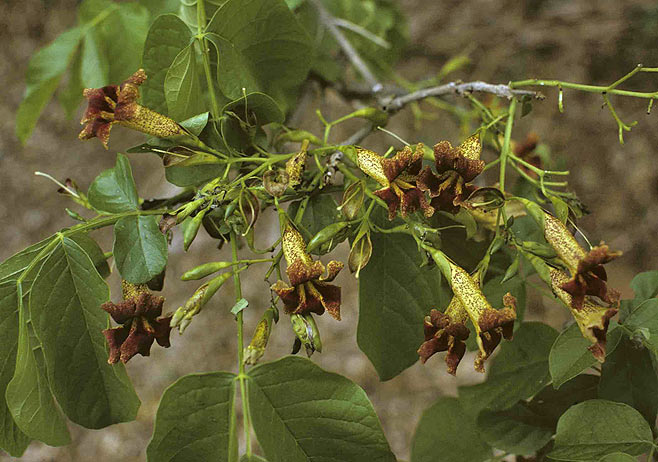|
Markhamia zanzibarica (Bell-bean, Maroon bell-bean)
Klokkiesboontjieboom [Afrikaans]; Mula-kholoma [Venda],
Mubikanyemba [Shona] Life
> eukaryotes >
Archaeoplastida >
Chloroplastida
>
Charophyta > Streptophytina > Plantae (land plants)
> Tracheophyta (vascular plants) > Euphyllophyta > Lignophyta (woody plants)
> Spermatophyta (seed plants) > Angiospermae (flowering
plants) > Eudicotyledons > Core Eudicots > Asterids > Euasterid I > Order: Lamiales
> Family: Bignoniaceae > Genus:
Markhamia
 |
|
Markhamia zanzibarica (Bell-bean, Maroon
bell-bean), Chipangayi River, Save Valley, Zimbabwe [photo
©
DCH Plowes, used with permission
from
Flora of Zimbabwe website] |
Description
A small tree, growing to a height of about 7 m. Has
compound leaves, with 2-4 pairs of leaflets plus a terminal one. Leaves often
have fine, yellow-coloured hairs, especially on the lower surface. The petiole
is often quite long, measuring 40-90 mm. Flowers are yellow, flecked with maroon
and are evidently attractive to large ants. Fruit is a slender capsule, up to 60
mm long. Branches are very brittle, breaking easily.
Distribution and habitat
Native to tropical Africa and within southern Africa is
found in the Caprivi region of Namiba, northern Botswana, most of Zimbabwe,
northern Mozambique, and northern South Africa (Limpopo provinice). Found along
the fringes of rivers and on rocky outcrops and hillsides.
Uses
-
The wood is fine-grained, yellowish and moderately
durable. It is used for roof timbers and implement handles. The quantity of
wood that can be derived from a tree is insufficient for most purposes.
-
The roots are roasted and ground into a powder, which
is rubbed into incised skin to relieve backache.
-
Trees are grown in gardens and can be propagated from
truncheons or from seed. This tree has been selected, along with
Diospyros whyteana
(Bladdernut) and
Harpephyllum caffrum
(Wild plum) as Tree of the Year for 2008 (see more on
Department of Water Affairs and Forestry website). For information on
how to grow it, see
PlantzAfrica.com.
Links
References
-
Palgrave, K.C. & Palgrave, M.C. 2002. Trees of
Southern Africa. Struik Publishers, Cape Town.
-
van Wyk, B. & van Wyk, P. 1997. Field Guide to the
Trees of Southern Africa. Struik Publishers, Cape Town.
Text by Hamish Robertson |
